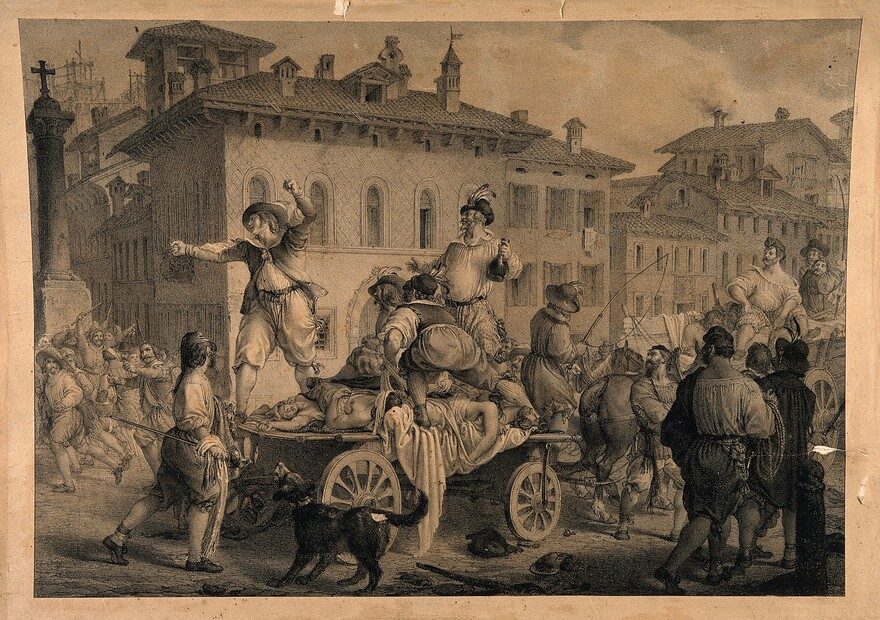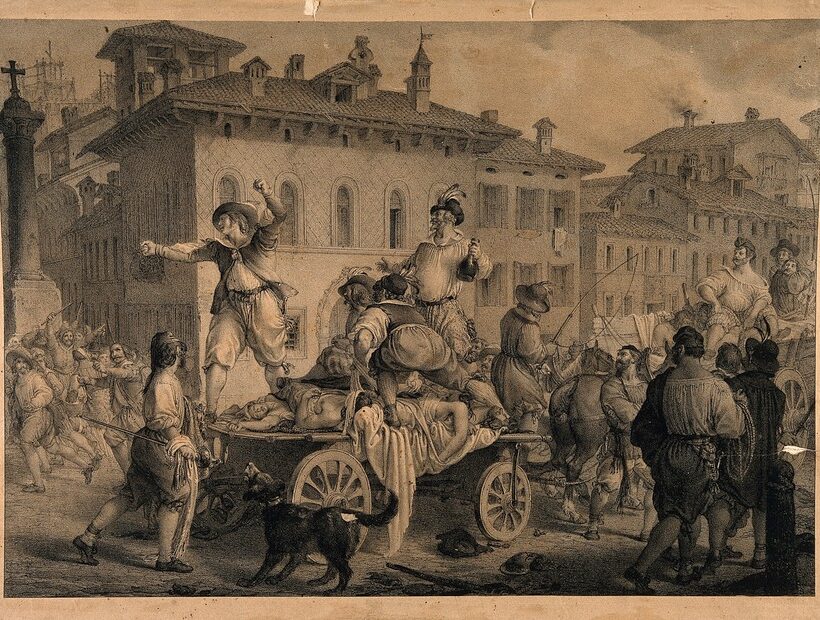According to the Art:
The Betrothed, by Alessandro Manzoni, is a literary explication of Italian history in the early sixteen hundreds, and which includes a section on the bubonic plague that ravaged Milan then. The factual reports of public reactions to the bubonic plague in the novel are compared here to factual reports of public reactions to the 2020 coronavirus pandemic in mainstream media. Not a lot changed in 400 years.
Background:
The Betrothed, a novel written by Alessandro Manzoni and first published in 1827, is an expression of the author’s interest in early seventeenth-century Italian history in the form of an accurate, literary explication of historical events, religious life, and social structures in the northern regions of the country at that time. The novel follows the plights of Renzo and Lucia—the betrothed—as events separate them before they could wed and as they make many frightful, forlorn, and futile attempts to reunite. Individually and together, these two unassuming, God-fearing “hill-folk” encounter oppression and succor of the Church, brutality and charity of the noble class, terror and wisdom of crowds, famine and bounty, war, and plague.
The section of the novel involving a plague draws from the historic and catastrophic bubonic plague that struck the Duchy of Milan in 1630 after French and German troops on their way to do battle in Mantua seeded the territory with the infection that would kill more than half the population. Manzoni relies on reports of observers there at the time.
We ourselves, with great diligence if nothing else, have examined and collated all the printed memoirs and several unpublished ones, and most of the few official documents that have survived…We do not intend to report all the official documents, nor even all the events which are in one way or another worthy of being recorded…We have merely tried to distinguish and to verify the most widely significant and most indispensable facts, to arrange them in the order in which they happened, as far as their causes and nature will permit, and to observe their interaction.
p. 565
The reporters Manzoni references most often are Ripamonti and Tadino.
Many of the descriptions of the plague in Milan that Manzoni offers from his sources mirror descriptions that have appeared in contemporary mainstream accounts about the coronavirus pandemic in the U.S. in 2020. Here I take excerpts from the novel and pair them with corresponding reports from those in the news media. In the following pairings, an excerpt from the book is first, followed by an excerpt from a current news report.
The version of The Betrothed serving for the quotes is this one:
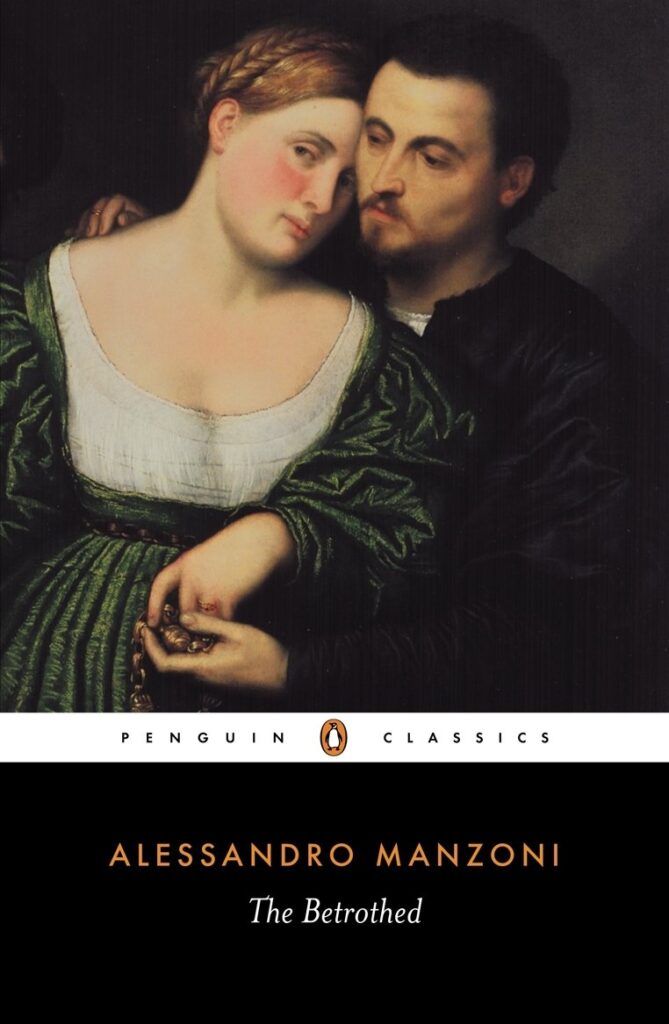
The Betrothed
Alessandro Manzoni
Bruce Penman (translator)
Penguin Books
New York
1972
720 pages
Pairings:
See no evil, hear no evil, speak no evil…
In the beginning, then, there had been no plague, no pestilence, none at all, not on any account. The very words had been forbidden.
Next came the talk of ‘pestilent fever’ – the idea being admitted indirectly, in adjectival form.
Then it was ‘not a real pestilence’ – that is to say, it was a pestilence, but only in a certain sense, but something for which it was difficult to find another name. (pp. 582-583)
———————————-
The health secretary, Alex Azar, calls Trump and briefs him on the coronavirus threat, but “Trump spent much of the conversation wanting to talk about vaping,” the AP reported. (The Guardian, April 14, 2020)
As the World Health Organization declares a global health emergency, Azar, the health secretary, again warns Trump about the looming threat. Taking Azar’s call en route to a campaign rally, Trump dismisses him as “alarmist,” the New York Times reported. (The Guardian, April 14, 2020)
Donald Trump used racist language to describe the coronavirus pandemic at a campaign rally in Tulsa, Oklahoma, by terming the virus as the “kung flu”…Trump has repeatedly tried to term Covid-19 as the “Chinese virus” or the “Wuhan virus” which has prompted outrage from many civil liberties groups, who have warned that such language can inspire racism and violence against Asian Americans. (The Guardian, June 20, 2020)
What’s the hurry…
The proclamation restricting entry to the city, which was the subject of a resolution by the commission on 30 October, was not finally drafted until the twenty-third of the following month, and not published until the twenty-ninth. By then, the plague had entered Milan. (p. 570)
———————————-
By the third week of February, advisers had drafted a list of measures they believed would soon be necessary, like school closures, sports and concert cancellations and stay-at-home orders, but the president did not embrace them until mid-March. (New York Times, April 14, 2020)
Did somebody say “party”…
The Governor was deeply grieved at the news [of the rapidly spreading and devastating plague], and shown himself keenly sensible of the situation…Two or three days later, the Governor issued a proclamation, in which he decreed public festivities for the birth of Prince Carlos, the first-born son of King Philip IV, oblivious or uncaring of the danger of a great public gathering in this circumstances—just as if the times had been normal, and no one had mentioned the plague to him at all. (p. 568)
———————————-
President Trump and his campaign held a controversial mid-pandemic indoor rally at the BOK Center in Tulsa, Oklahoma against the advice of the top two infectious-disease experts on the White House coronavirus task force and countless other public-health experts, including the head of the Tulsa Public Health Department. Instead, the Trump team repeatedly dismissed the risks of holding the rally (despite a surge of coronavirus infections in Oklahoma, Tulsa, and numerous states around the country); made attendees waive their right to sue the campaign should they catch the coronavirus there; and refused to mandate face masks or social distancing at the venue. (New York Magazine, June 27, 2020)
Kill the messenger…
Whenever it did succeed in discovering a case, the commission of health isolated houses, had their contents burned, and sent off whole families to the lazaretto [quarantine facilities] – and so it is easy to imagine what angry complaints arose against it from the public at large…convinced that these were mere unreasoning and pointless acts of harassment. The odium fell on the two doctors…and it reached a point where they could not cross the squares of the city without being assailed with curses, or even stones…and were regarded as enemies of their country. (pp. 572-573)
———————————-
Dr. Fauci has been the Trump administration’s most outspoken advocate of social distancing rules that have shuttered the nation’s schools, forced businesses to close, kept people in their homes and battered the United States economy. That has made him a target of online conspiracy theorists who have accused Dr. Fauci, a longtime scientist and civil servant who has served presidents of both parties, of trying to undermine Mr. Trump during a year in which the president is fighting for re-election. ‘Upon the recommendation of the U.S. Marshals Service, the department approved the special deputization request from H.H.S. for nine H.H.S.-O.I.G. special agents to provide protective services for Dr. Fauci,’ the Justice Department said. (New York Times, April 1, 2020)
Follow the leader…
Father Felice was now in charge of the place, with the fullest authority over everybody there…He inspired and controlled everything; he calmed riots, solved disputes, threatened, punished, reproved and comforted; he dried the tears of others and shed tears of his own. (p. 576)
———————————-
“This is really what he’s (Andrew Cuomo) built for,” Weingarten said. “He has the mind, the analytical sense and the combination of moxie and smarts and bulldoggish-ness that has made him both respected, and questioned, for all these years. But what you’re also starting to see is great empathy and great leadership.” (Forbes, April 6, 2020)
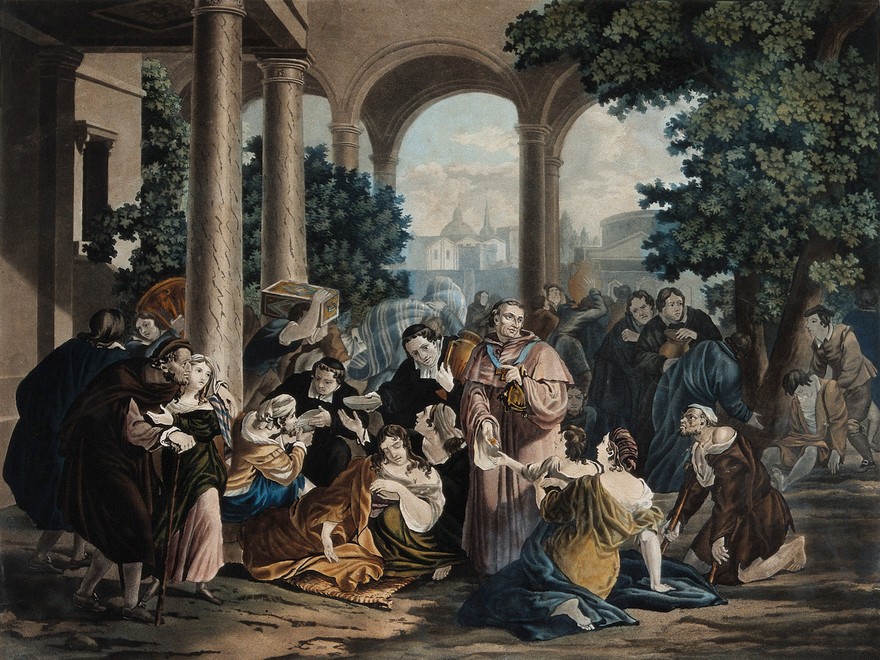
Coloured aquatint by L.A. Garneray, 1820, after Martinet
Credit: Wellcome Collection. Attribution 4.0 International (CC BY 4.0)
Deny, deny, deny, until…
The obstinate reluctance of the public to admit the there was a plague naturally began to weaken and fade away, as the disease spread more and more widely by an obvious process of infection through contact; especially when the scourge, after some time of being confined to the poor, began to strike at men of more note. (p. 577)
———————————-
Gov. Greg Abbott of Texas has finally allowed individual cities and counties to mandate wearing masks, after initially overruling such orders. For all the denialism and politicking, scientists have managed to learn quite a bit in recent months about this coronavirus: They’re fairly certain now that it can spread from normal breathing (as opposed to just coughing), that an infected person who isn’t showing any symptoms can pass the virus to others and that even simple cloth masks can prevent such transmissions. (New York Times, June 23, 2020)
Blame it on the bossanova…
Poisonous arts, diabolical operations, conspiracies of people bent on spreading the plague by contagious venoms or by black magic…Similar theories had been maintained and believed in many previous pestilences; and not least in the same city of Milan, during the epidemic of half a century earlier. (p. 578)
———————————-
The US president has endorsed the idea that the coronavirus originated in the Institute of Virology in Wuhan. He has also speculated that it might have been deliberately manufactured – an idea his own intelligence agencies have explicitly repudiated…A Chinese foreign ministry spokesman, Zhao Lijian, has floated the evidence-free idea that coronavirus might have originated in the US. (Financial Times, May 4, 2020)
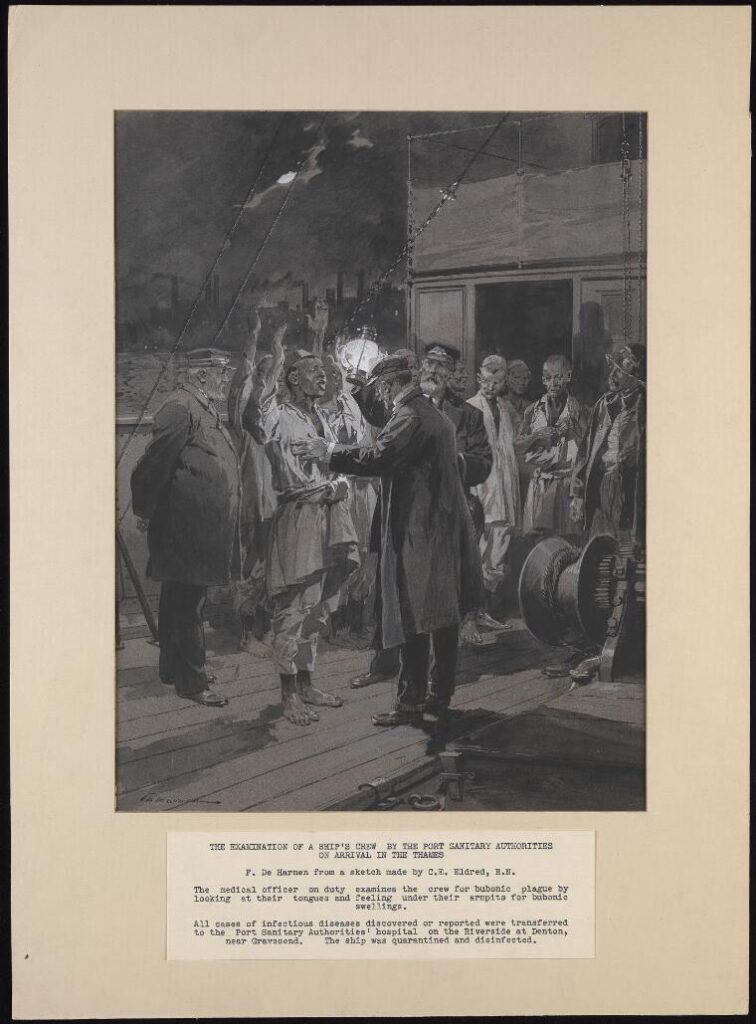
Watercolour drawing by F. de Haanen, 1905, after C.E. Eldred.
Credit: Wellcome Collection. Attribution 4.0 International (CC BY 4.0)
Gotta run…
The Governor said he was sorry not to be able to stay in the city and devote all his energies to the relief of its troubles, but hoped that the zeal of the decurions [member of city senate] would be enough to provide for everything. This, he said, was a time to spend freely, to use every resource to the full. (p. 584)
———————————-
The White House’s focus on the coronavirus has faded from public view in recent days as national unrest dominates headlines. The administration’s task force has scaled back its meetings, and its top infectious diseases expert, Anthony Fauci, said he hasn’t met with President Trump in weeks. The White House’s designated testing czar, Brett Giroir, likewise said Monday he is set to return to his regular duties this month, and the president has shifted his focus to quashing protests nationwide in response to the death of George Floyd. (The Hill, June 2, 2020)
Don’t stand so close…
They walked along cautiously, keeping themselves to themselves, with measured pace and suspicious air, in a way which suggested haste and hesitation at the same time; for everything they saw was a potential deadly weapon which might be turned against them. (p. 615)
———————————-
The evidence appears to support…staying 1 meter away from other people to reduce your chance of catching Covid-19 by 80%. Wearing a mask or face covering appears to reduce your risk by up to 85%. And wearing goggles or a face shield seems to reduce it by up to 78%…Even when properly used and combined, distancing, masks and eye protection do not offer complete protection, the study stressed, and basic measures like hand washing are essential to reduce transmission. (CNN, June 1, 2020)
Open and closed…
A presumptuous confidence that the procession [carrying the body of a revered archbishop] had put an end to the plague – in many cases a fanatical certainty that it was so – reigned everywhere the following day; and that very day the death-rate increased in every part of the city, and in every social class, to such an excessive level, with such a sudden jump, that no one could fail to see that its cause, or at least its occasion, lay in the procession itself. (p. 591)
———————————-
With new cases surging in many parts of the country, at least a dozen states and cities are pulling back on reopening plans…In Arizona, where case counts are soaring, Gov. Doug Ducey paused operations of bars, gyms, movie theaters and water parks for 30 days and banned indoor and outdoor public events or gatherings of 50 or more people…Several other cities and counties across the state are also moving to reimpose restrictions in response to the surge, which has followed the reopening of beaches, bars, restaurants and other social activities. (New York Times, June 29, 2020)

Photograph. Credit: Wellcome Collection. Attribution 4.0
Send in the…
The lazaretto had to be kept supplied with doctors, surgeons, medicines, good and all the equipment of a hospital. More accommodation had to be found and got ready for the fresh crowds of the sick who arrived every day. So huts of wood and straw were set up in the courtyard of the lazaretto. (p. 593)
———————————-
With coronavirus threatening to overwhelm New York hospitals, state officials are considering turning landmark locations like the Jacob K. Javits Convention Center into makeshift hospitals…The U.S. Army Corps of Engineers is also seriously looking at other locations including two at State University of New York campuses on Long Island, and at the Westchester Convention Center. Doctors have said the number of hospital beds available will dwindle as cases of the virus soar. (New York Times, March 21, 2020)
So many bodies…
Near the lazaretto a large communal grave had been dug – but only one. When it was full of bodies, the corpses of the newly dead began to remain unburied, not only in the lazaretto but everywhere in the city, and there were more of them every day than the day before. (p. 594)
———————————-
New York’s potter’s field became an unlikely savior during the coronavirus crisis — more than quintupling its usual pace of burials during the height of the pandemic. With funeral homes and morgues overflowing with corpses as the disease ravaged the city, Hart Island took 894 bodies between March 9 and Friday…Several funeral homes in the city were seen storing corpses outside in the open, or in unrefrigerated trucks. (New York Post, June 27, 2020)
Comment:
The excerpts I chose focus on human responses to a deadly plague that work against the interests of most of the people affected, and how these reactions could have worsened the spread of the plague. That’s not to say the novel doesn’t portray acts of kindness and generosity, or that such accounts are not found with great frequency in contemporary news media coverage of the 2020 coronavirus pandemic. But, with apologies to Tolstoy, all beneficent human responses are alike; each self-serving, cynical, and inhumane response is such as it is in its own way. Thus, concentrating on responses stemming from human folly rather than kindness yields an expanded view of the human condition warped by the effects of infectious pandemics that threaten existence. And, comparing reports from pandemics occurring four centuries apart from one another shows the persistence in human folly under the most threatening of circumstances.
Also:
Figure with title is:
Accusing the Anointersin the great plague of Milan in 1630; a scene from Manzoni’s ‘I promessi sposi’
Lithograph by G. Gallina after A. Manzoni.
Credit: Wellcome Collection.
Attribution 4.0 International (CC BY 4.0)
